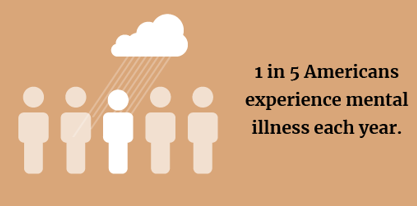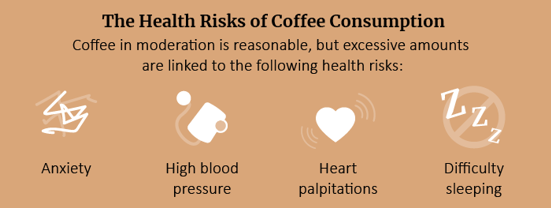Live Well, Work Well May 23 Newsletter
Share
Boosting Your Daily Mental Health
 Mental Health Awareness Month, observed every May, is a time to raise awareness and break the stigma about mental health, and support people with mental illness. In fact, more than half of adults in the United States will be diagnosed with a mental illness—a variety of conditions that affect one’s mood, behavior, feelings or thinking—at some point in their life.
Mental Health Awareness Month, observed every May, is a time to raise awareness and break the stigma about mental health, and support people with mental illness. In fact, more than half of adults in the United States will be diagnosed with a mental illness—a variety of conditions that affect one’s mood, behavior, feelings or thinking—at some point in their life.

Mental health plays a huge role in your overall health and well-being. It affects everything, including how you think, feel and act, and helps determine how you make healthy choices and cope with stress. Because it’s such a crucial component of your wellness, focusing on maintaining or improving your mental health is important. Here are five ways to boost or prioritize your mental health every day:
- Express gratitude. Taking five minutes daily to write down the things you are grateful for has been proven to lower stress levels and can help you achieve a more positive mindset.
- Get moving. Exercising regularly can benefit your brain function, reduce anxiety and improve your self-image.
- Spend time outdoors. Getting outside, especially when it’s sunny, can greatly improve your mood, which benefits your mental health.
- Be kind. Helping others and being kind not only helps the recipient, but can also benefit your mental health. Simply holding the door for someone or giving a compliment can go a long way.
- Get a good night’s sleep. Fatigued individuals typically experience drowsiness, mood changes, loss of energy and appetite, headaches, and a lack of motivation, concentration and alertness. Strive for seven to eight hours of sleep a night.
Seek help from your primary care doctor or a mental health professional if you’re concerned about your mental health. If you need mental health-related crisis support, or are worried about someone else, the 988 Suicide and Crisis Lifeline is available by calling or texting 988 and chatting online at 988lifeline.org.
Caffeine Withdrawal Symptoms? Decaf Can Help
According to Drive Research, about 75% of Americans drink coffee every day, and half of the surveyed adults drink three to five cups daily. Unfortunately, drinking too much coffee may have negative side effects on your health. But if you’re reducing your coffee intake, you may experience caffeine withdrawal symptoms, making it more challenging to cut back. Common symptoms include headache, fatigue and irritability.
 Fortunately, new research from the University of Sydney has a tip for people trying to drink less coffee. Researchers found drinking a cup of high-quality decaffeinated coffee temporarily reduces withdrawal symptoms. The study noted that the cup of decaffeinated coffee should taste like the real deal to have an impact. The point was that some study participants were unaware they were drinking decaf. This is due to conditioning. Many people associate coffee and its surrounding stimuli (e.g., taste and smell). Therefore, a quality cup of decaffeinated coffee can offer those same experiences without caffeine.
Fortunately, new research from the University of Sydney has a tip for people trying to drink less coffee. Researchers found drinking a cup of high-quality decaffeinated coffee temporarily reduces withdrawal symptoms. The study noted that the cup of decaffeinated coffee should taste like the real deal to have an impact. The point was that some study participants were unaware they were drinking decaf. This is due to conditioning. Many people associate coffee and its surrounding stimuli (e.g., taste and smell). Therefore, a quality cup of decaffeinated coffee can offer those same experiences without caffeine.
If you have concerns about your coffee consumption, talk to your doctor.
Improving Your Relationship With Your Phone
Smartphones have made our lives so much easier, but they can also impact our physical and mental well-being. To build a healthier relationship with your phone, try the following strategies:
- Turn off notifications. Disable notifications for social media apps or mute group chats to avoid being tempted by distractions.
- Check at specific times. Create achievable boundaries by checking your phone at certain times or leaving your phone in another room.
- Avoid use before bed. Try to cut down on phone use in bed or right before sleeping. The bright screen can signal to your body that it’s time to be awake, so you may have trouble falling asleep or experience lower sleep quality.
Start small to create an action plan that works for your life and schedule.
Recipe
Stuffed Bell Peppers
Makes: 5 servings
Ingredients
5 bell peppers (any color)
1 pound 90% lean ground beef
¾ cup brown rice
½ can of diced low-sodium tomatoes
3 Tbsp. lemon juice
¼ tsp. cinnamon
¼ tsp. allspice
¼ tsp. ground black pepper
Preparations
1. Cut a circular hole in the tops of the bell peppers. Remove the seeds and membrane and set aside.
2. In a large bowl, combine the remaining ingredients and stir until completely mixed. Fill the bell peppers with the meat mixture.
3. Place the stuffed bell peppers on the stove in a large stock pot with the tops facing up. Add one inch of water to the bottom of the pot and cover.
4. Place the heat on medium, keeping covered for 30-40 minutes until the rice is done.
Nutritional Information (per serving)
Total calories 277
Total fat 8 g
Protein 21 g
Sodium 66 mg
Carbohydrate 29 g
Dietary fiber 4 g
Saturated fat 3 g
Total sugars 4 g
Source: MyPlate

